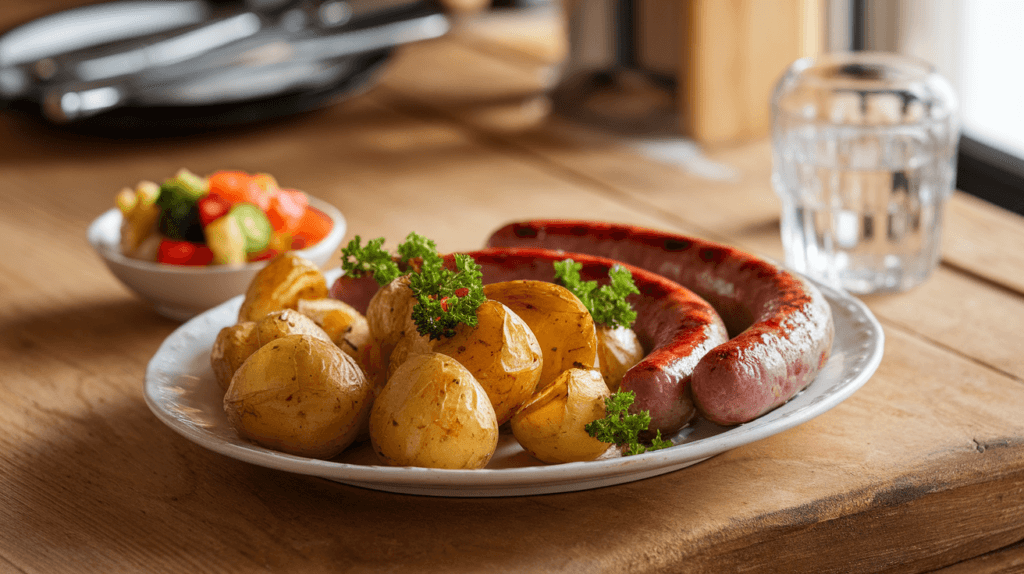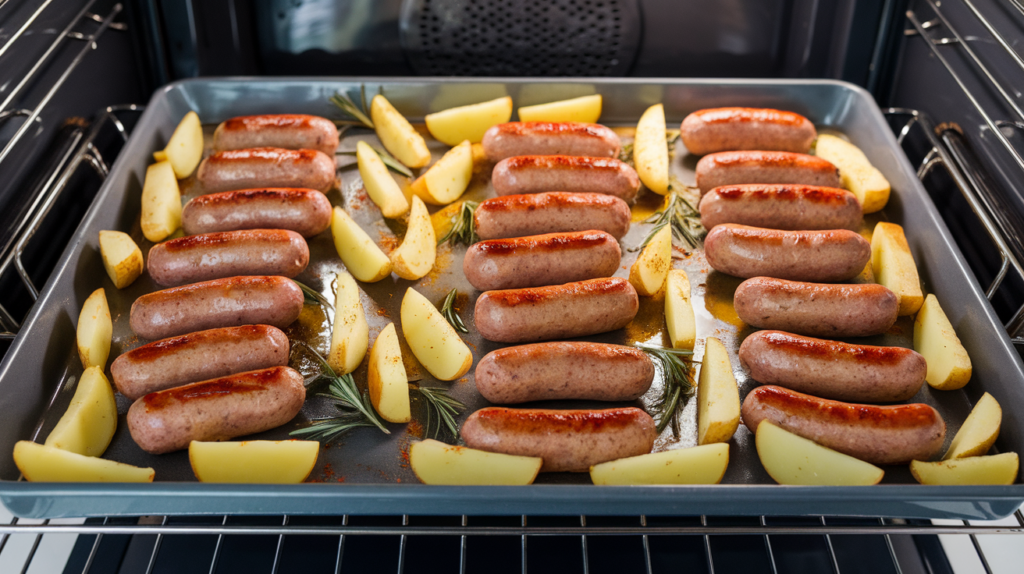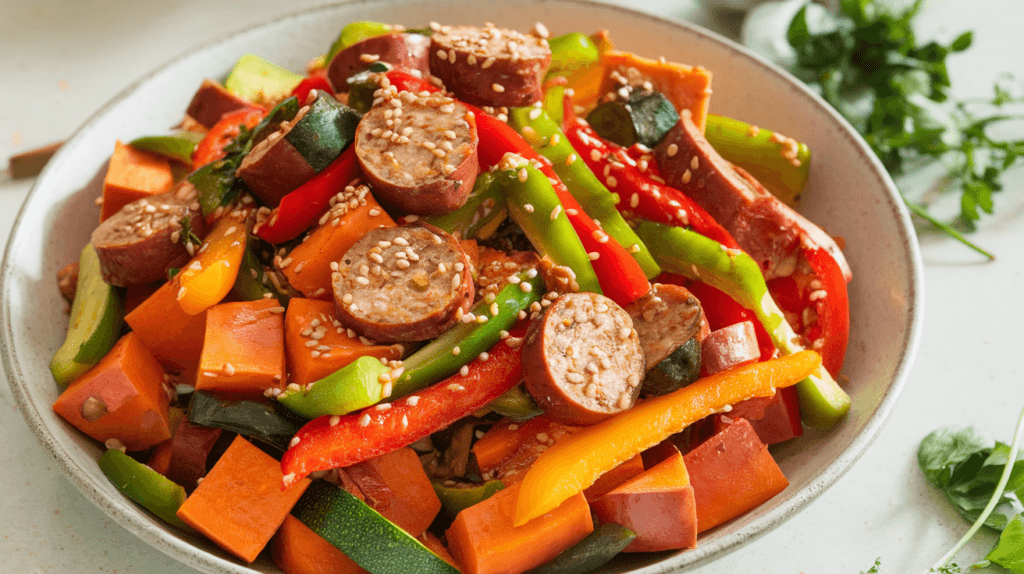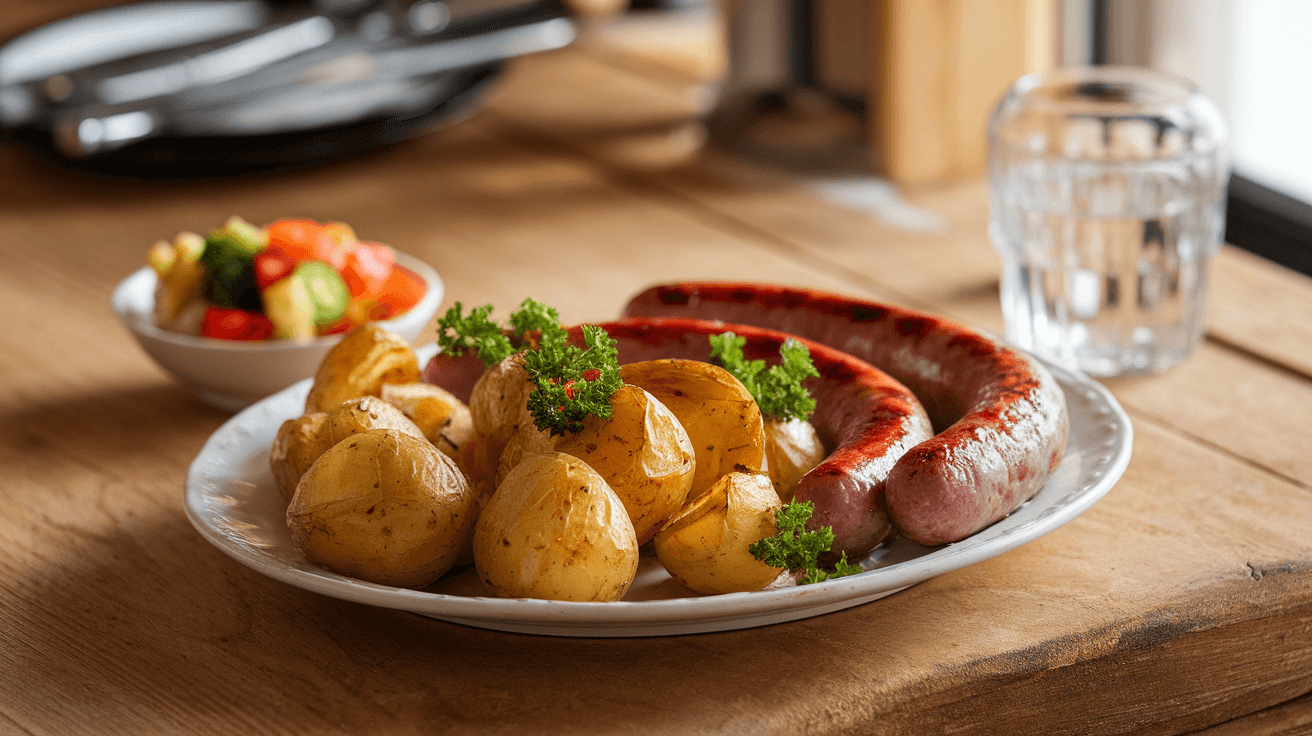Introduction
Potatoes and sausage are a beloved combination in many cuisines worldwide. Whether it’s a hearty breakfast skillet or a comforting dinner, the pairing is versatile and delicious. However, many people wonder: are potatoes and sausage healthy? The answer depends on various factors, including how they’re prepared and the overall balance of your diet. In this article, we’ll dive into the nutritional details of potatoes and sausage, examine their health benefits and risks, and explore ways to make this classic meal healthier.

Are Potatoes Healthy? A Nutritional Overview
What Nutrients Make Potatoes Healthy?
Potatoes are often misunderstood as a “bad carb,” but they are packed with essential nutrients. A medium-sized potato contains a healthy dose of potassium, vitamin C, and fiber. Additionally, potatoes are low in fat and can be a great source of complex carbohydrates, which provide sustained energy throughout the day.
How Are Potatoes Healthy for You?
The nutrients in potatoes contribute to several health benefits. Potassium, for example, supports heart health by helping to regulate blood pressure. Meanwhile, the fiber content in potatoes aids digestion and promotes gut health. When consumed in moderation and prepared healthily, potatoes can be a nutritious addition to your diet.
Is Sausage Healthy? A Nutritional Overview
What Types of Sausages Are Healthiest?
Sausages come in a wide variety of types, including pork, chicken, turkey, and plant-based options. Each type has a different nutritional profile, influenced by the ingredients and preparation methods. Traditional sausages are often made with ground meat, seasonings, and sometimes fillers like breadcrumbs or grains. More recently, plant-based sausages have gained popularity as a lower-fat and cholesterol-free alternative.
Can Sausage Be Healthy? Key Benefits
Sausage, particularly those made from lean meats or plant-based sources, can be a good source of protein. Protein is essential for muscle growth, tissue repair, and overall body function. Certain sausages also contain vitamins and minerals like iron and B vitamins, which play a role in energy production and red blood cell formation.
When Is Sausage Unhealthy? Risks to Know
Despite their benefits, many sausages are high in saturated fats, sodium, and preservatives, which can negatively impact health if consumed in excess. Processed meats have also been linked to an increased risk of certain health conditions, such as heart disease and cancer. Choosing minimally processed sausages with lower sodium content is a healthier option.
Are Potatoes and Sausage a Balanced and Healthy Meal?
Balancing Macronutrients in a Potato and Sausage Meal
The combination of potatoes and sausage provides a mix of carbohydrates, proteins, and fats. Potatoes are rich in complex carbohydrates, which serve as the body’s primary energy source. Sausage, on the other hand, is a good source of protein and fat. To create a more balanced meal, it’s essential to ensure the portion sizes are appropriate and the preparation methods are healthy.
How to Make Potatoes and Sausage Healthier with Vegetables
One way to improve the healthiness of a potato-and-sausage dish is by incorporating vegetables. Leafy greens, bell peppers, onions, and zucchini not only enhance the flavor but also add fiber, vitamins, and minerals. This reduces the calorie density of the meal and increases its overall nutrient content, making it more satisfying and balanced.
Choosing the Right Types of Sausages and Potatoes
For a healthier meal, opt for lean sausages such as chicken or turkey varieties. For potatoes, stick to whole, unprocessed options like red or sweet potatoes, which have a higher nutrient content compared to processed potato products like fries or chips. Preparing these ingredients with minimal added fats ensures the meal remains nutritious.
What Are the Health Benefits of Potatoes and Sausage?
Protein and Carb Synergy
The pairing of potatoes and sausage offers a synergistic balance of protein and carbohydrates. The protein in sausage helps repair and build muscles, while the complex carbohydrates in potatoes provide long-lasting energy. This combination makes the meal particularly beneficial for active individuals or those looking to replenish energy stores after physical activity.
Energy-Boosting Properties
Potatoes, as a source of complex carbohydrates, are excellent for sustaining energy levels without causing rapid blood sugar spikes. When paired with protein-rich sausage, the digestion process is slowed down, providing a steady release of energy. This makes the combination ideal for meals intended to keep you fueled throughout the day.
Source of Essential Nutrients
Both potatoes and sausage contribute key nutrients to a meal. Potatoes are high in potassium, which supports muscle function and cardiovascular health. Sausages, especially those made with lean meats, provide iron and vitamin B12, crucial for maintaining healthy blood cells and preventing anemia.
Are Potatoes and Sausage Healthy? Potential Risks Explained
Sodium Concerns in Sausage
One of the main drawbacks of sausage is its high sodium content. Excessive sodium intake can lead to increased blood pressure, putting strain on the heart and potentially leading to cardiovascular issues. When consuming sausage, it’s important to balance sodium intake by pairing it with low-sodium foods like fresh vegetables and unprocessed potatoes.
Fried Potatoes and Health
Potatoes themselves are healthy, but the method of preparation significantly affects their nutritional value. Fried potatoes, such as French fries, are high in unhealthy fats and calories, which can contribute to weight gain and other health problems. Baking, roasting, or boiling potatoes are healthier options that retain their nutrients without adding unnecessary fats.
Processed Sausages and Additives
Many commercially available sausages are highly processed and contain preservatives like nitrates and nitrites. These additives have been linked to potential health risks, including an increased risk of certain cancers. Opting for fresh or minimally processed sausages can help mitigate these concerns while still enjoying the flavor they bring to meals.
How to Cook Potatoes and Sausage for a Healthier Meal

Roasting vs. Frying
Cooking methods can drastically impact the healthiness of potatoes and sausage. Roasting is an excellent alternative to frying, as it requires minimal oil while still providing a crispy texture and rich flavor. Frying, on the other hand, adds excess fat and calories, which can negate the nutritional benefits of the ingredients.
Using Herbs and Spices Instead of Salt
To enhance the flavor of potatoes and sausage without adding extra sodium, consider using herbs and spices. Garlic, rosemary, paprika, and thyme are great options that elevate the dish while supporting heart health. Replacing salt with natural seasonings can make the meal both healthier and more flavorful.
Incorporating Steaming and Grilling
Steaming vegetables and grilling sausage are other healthy preparation methods. Grilling reduces the fat content in sausage by allowing excess grease to drip away. Steaming vegetables and potatoes preserves their nutrients while maintaining a fresh, vibrant taste, making them a perfect accompaniment to sausage.
When Are Potatoes and Sausage Not Healthy?
Individuals with Specific Health Conditions
People with certain health conditions, such as high blood pressure or heart disease, may need to limit their consumption of sausage due to its high sodium and saturated fat content. Similarly, those managing diabetes should monitor their potato intake carefully to avoid blood sugar spikes, especially when consuming processed or fried potatoes.
Allergies and Dietary Restrictions
Some individuals may have allergies to ingredients commonly found in sausages, such as gluten, soy, or certain spices. Additionally, vegetarians and vegans will need to choose plant-based sausage alternatives. Being mindful of these dietary restrictions ensures that everyone can enjoy a version of this dish that aligns with their health and preferences.
Practical Tips for Making Potatoes and Sausage Healthier
Portion Control
One of the easiest ways to enjoy potatoes and sausage healthily is by practicing portion control. Stick to a single serving of sausage and balance it with a larger portion of vegetables and moderate servings of potatoes. This ensures you’re not consuming excess calories or sodium.
Pairing with Whole Grains
To enhance the nutritional value of your meal, consider pairing potatoes and sausage with whole grains such as quinoa, brown rice, or barley. These grains add fiber, which supports digestion and helps you feel fuller for longer.
Experimenting with Plant-Based Alternatives
For those looking to reduce fat and cholesterol intake, plant-based sausages are a great alternative. Pair these with roasted sweet potatoes for a nutrient-packed meal that’s lower in calories and saturated fats but still rich in flavor.
Using Low-Fat Cooking Oils
When preparing potatoes and sausage, use low-fat cooking oils such as olive or avocado oil instead of butter or lard. These healthier fats are beneficial for heart health and can add a delicious flavor to your dish.
Alternatives to Traditional Potatoes and Sausage Dishes

Sweet Potato and Turkey Sausage Skillet
For a healthier twist, swap regular potatoes for sweet potatoes and traditional pork sausage for lean turkey sausage. Sweet potatoes are rich in vitamin A and fiber, while turkey sausage is lower in saturated fat. This combination offers a flavorful and nutrient-dense meal option.
Vegetarian Potato and Sausage Stir-Fry
Try using plant-based sausages along with a medley of roasted potatoes, bell peppers, and zucchini. This vegetarian-friendly dish is packed with fiber and antioxidants, making it a heart-healthy alternative to the classic recipe.
Baked Sausage and Potato Casserole
A baked casserole allows you to incorporate more vegetables, such as spinach, broccoli, or mushrooms, alongside sliced potatoes and sausage. Use a light cheese or plant-based sauce to reduce the calorie content while still enjoying a creamy, comforting dish.
Potato and Sausage Soup
For a lighter option, create a potato and sausage soup using broth, lean sausage, and diced potatoes. Adding greens like kale or spinach boosts the nutrient content, and using a low-sodium broth keeps the dish heart-friendly.
FAQs
Is it okay to eat potatoes and sausage every day?
While potatoes and sausage can be part of a healthy diet, daily consumption may not be ideal due to the high sodium and fat content in sausages. Balancing this meal with other nutrient-rich foods is recommended.
Are plant-based sausages healthier than traditional ones?
Plant-based sausages are often lower in saturated fat and cholesterol but may still contain sodium and preservatives. Always check the nutrition label to ensure they align with your health goals.
What are the healthiest ways to cook potatoes?
Baking, boiling, or steaming potatoes are the healthiest options as they retain the most nutrients without adding excess fat or calories. Avoid frying for a healthier preparation.
How can I reduce sodium in a potato and sausage dish?
Choose low-sodium sausage options and avoid adding salt during cooking. Incorporating fresh vegetables and herbs can also enhance flavor without relying on salt.
Can I make this meal suitable for weight loss?
Yes! Use lean sausages, such as chicken or turkey, and pair them with baked or steamed potatoes. Adding a generous portion of vegetables helps create a lower-calorie, nutrient-dense meal.
Are sweet potatoes a better choice than white potatoes?
Sweet potatoes have a lower glycemic index and are higher in certain nutrients like vitamin A, making them a slightly healthier option than white potatoes, depending on your dietary needs.
Conclusion
Potatoes and sausage can be part of a healthy diet when prepared thoughtfully. By choosing lean sausage options, avoiding frying, and incorporating vegetables, this meal can be both delicious and nutritious. Moderation is key, as overindulgence in high-fat and high-sodium foods can have negative health effects. With careful planning and healthier cooking methods, you can enjoy this classic pairing without compromising your health.

